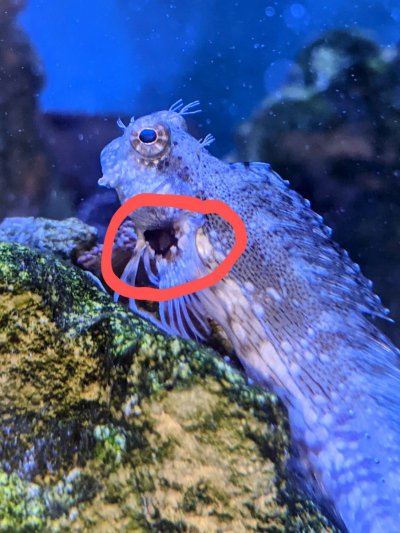Navigation
Install the app
How to install the app on iOS
Follow along with the video below to see how to install our site as a web app on your home screen.
Note: This feature may not be available in some browsers.
More options
You are using an out of date browser. It may not display this or other websites correctly.
You should upgrade or use an alternative browser.
You should upgrade or use an alternative browser.
Lawnmower Blenny with black spot
- Thread starter ___
- Start date
- Tagged users None
vetteguy53081
Well known Member and monster tank lover
View Badges
Partner Member 2024
Excellence Award
Reef Tank 365
RGB
Article Contributor
Tampa Bay Reef Keepers
West Palm Beach Reefer
Hospitality Award
Ocala Reef Club Member
305 Reef Club
Wisco Reefers
Midwest Reefer
Fish Medic
MAC of SW Florida
Rock Pool Reef Keepers
R2R Secret Santa 2023
My Tank Thread
My Aquarium Showcase
Its either pigment change based on diet or infection but see either being the answer .
They do require diet other than the belief they only need algae. Water quality also of importance. The trickiest part about keeping a blenny is making sure it gets enough to eat. You can tell this visually by looking at the abdomen, which should be a healthy rounded shape. A blenny with a pinched midriff isn’t finding enough food.
Although a blenny needs plenty of algae to survive, a common misconception is that it can survive on algae alone. Since blennies frequent shallow tropical waters, they find their sanctuary within the coral reefs. They circle areas with coral branches and sponges, scraping their way along the diverse sea bottom. Their feeding techniques are to pound and gnaw the coral, and as a result, they ingest detritus, or waste material primarily, from the coral. This includes bits of coral skeleton, sand, gravel, and other organic matter, such as fish eggs and tiny crustaceans.
Since a blenny in the wild does not subsist on solely algae, it stands to reason that their captive diet must be supplemented. If a blenny is not getting enough calcium carbonate in its diet, its condition will rapidly deteriorate. Therefore, it is important to offer an occasional selection of commercial algae-based wafers or pellets.
They do require diet other than the belief they only need algae. Water quality also of importance. The trickiest part about keeping a blenny is making sure it gets enough to eat. You can tell this visually by looking at the abdomen, which should be a healthy rounded shape. A blenny with a pinched midriff isn’t finding enough food.
Although a blenny needs plenty of algae to survive, a common misconception is that it can survive on algae alone. Since blennies frequent shallow tropical waters, they find their sanctuary within the coral reefs. They circle areas with coral branches and sponges, scraping their way along the diverse sea bottom. Their feeding techniques are to pound and gnaw the coral, and as a result, they ingest detritus, or waste material primarily, from the coral. This includes bits of coral skeleton, sand, gravel, and other organic matter, such as fish eggs and tiny crustaceans.
Since a blenny in the wild does not subsist on solely algae, it stands to reason that their captive diet must be supplemented. If a blenny is not getting enough calcium carbonate in its diet, its condition will rapidly deteriorate. Therefore, it is important to offer an occasional selection of commercial algae-based wafers or pellets.
Thank you. He gets a mix of food, including eggs and pellets. He's also been munching on some shells and coral edges. I'll keep an eye on him and see how it goes, thanks again!Its either pigment change based on diet or infection but see either being the answer .
They do require diet other than the belief they only need algae. Water quality also of importance. The trickiest part about keeping a blenny is making sure it gets enough to eat. You can tell this visually by looking at the abdomen, which should be a healthy rounded shape. A blenny with a pinched midriff isn’t finding enough food.
Although a blenny needs plenty of algae to survive, a common misconception is that it can survive on algae alone. Since blennies frequent shallow tropical waters, they find their sanctuary within the coral reefs. They circle areas with coral branches and sponges, scraping their way along the diverse sea bottom. Their feeding techniques are to pound and gnaw the coral, and as a result, they ingest detritus, or waste material primarily, from the coral. This includes bits of coral skeleton, sand, gravel, and other organic matter, such as fish eggs and tiny crustaceans.
Since a blenny in the wild does not subsist on solely algae, it stands to reason that their captive diet must be supplemented. If a blenny is not getting enough calcium carbonate in its diet, its condition will rapidly deteriorate. Therefore, it is important to offer an occasional selection of commercial algae-based wafers or pellets.
Similar threads
- Replies
- 5
- Views
- 152
- Replies
- 6
- Views
- 170
- Replies
- 1
- Views
- 104
- Replies
- 12
- Views
- 286
- Replies
- 2
- Views
- 143













